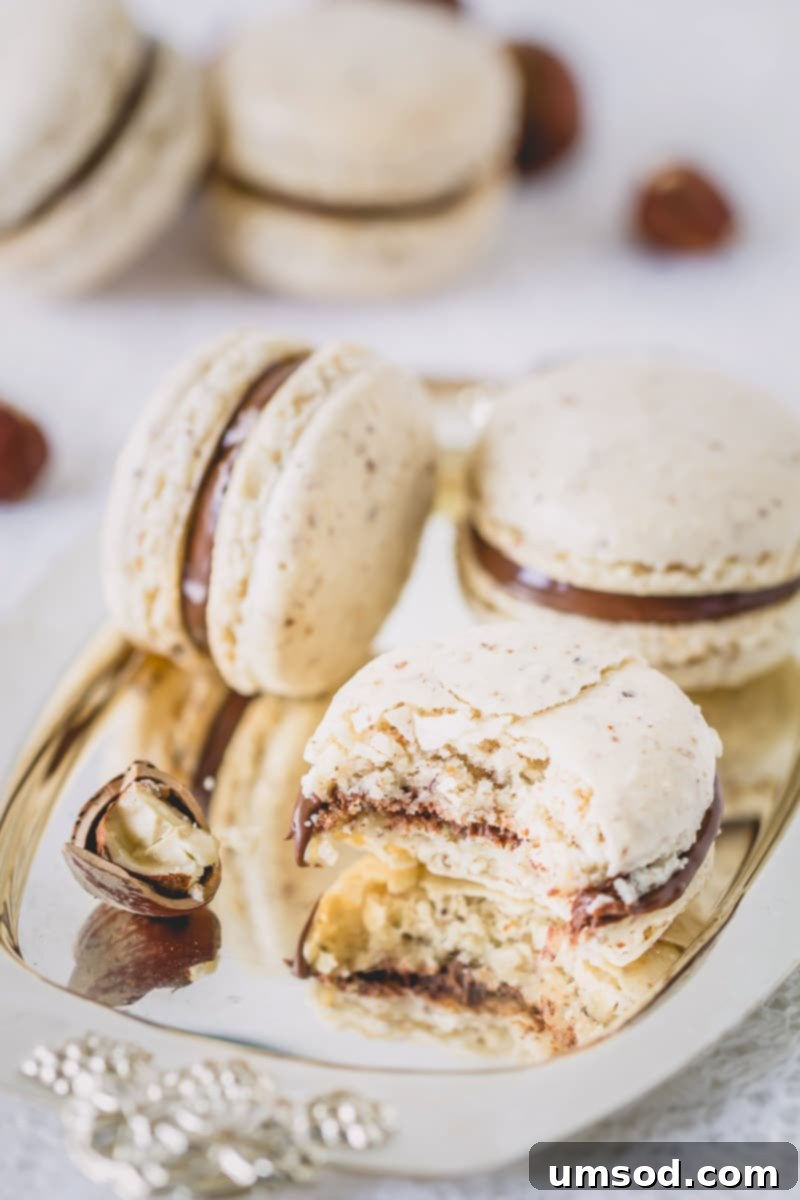Welcome to a delightful journey into the world of French patisserie, where we master the art of creating exquisitely delicate chocolate hazelnut macarons. These aren’t just cookies; they are tiny masterpieces, boasting charming speckles of hazelnut flour that make them as visually appealing as they are irresistibly delicious. And for a touch of pure indulgence that makes these treats even more accessible, we’re taking a delightful shortcut with the filling: glorious Nutella!

Planning to bake later? Pin this recipe now!
Pin It for Later
The Allure of Hazelnut Flour in Macarons: A Delectable Twist
While almond flour is the traditional base for French macarons, the world of macaron baking is wonderfully versatile! Yes, you can absolutely create stunning macarons using various nut flours. Many bakers, including myself, frequently experiment with hazelnut flour or pistachio flour to introduce unique flavor profiles and textures.
Today, we’re diving into the rich, nutty notes of chocolate hazelnut macarons, crafted with a thoughtful combination of hazelnut flour and almond flour. This particular blend is key to achieving perfect macaron shells that are both flavorful and structurally sound.
You might wonder why we opt for a mix rather than pure hazelnut flour. The reason lies in the fat content. Hazelnut flour naturally contains a higher percentage of fat compared to almond flour. When it comes to the delicate science of macarons, excessive fat can be a significant obstacle, leading to shells that don’t form feet properly or lack their characteristic crispness.
Understanding Nut Flour Fat Content
To put it into perspective, a 28-gram serving of almond flour typically contains around 14 grams of fat. The same quantity of hazelnut flour, however, contains approximately 17 grams of fat. This seemingly small difference can profoundly impact the meringue’s stability and the macaron’s final texture, underscoring the importance of careful ingredient ratios in macaron mastery.
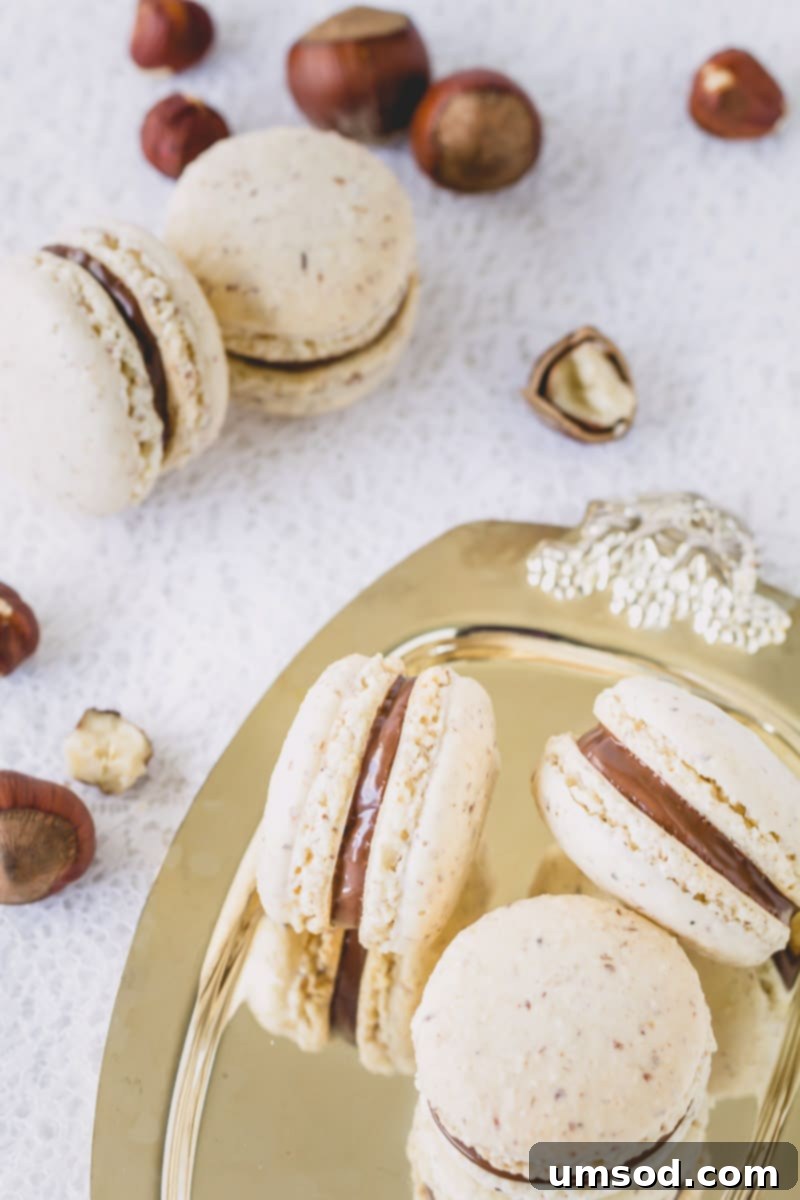
Mastering the Macaron Technique: A Step-by-Step Guide to Chocolate Hazelnut Macarons
Crafting perfect macarons is an art that blends precision with patience. If you’re looking for an in-depth exploration of the foundational techniques, I recommend reviewing my comprehensive basic macaron recipe. Here, we’ll focus on the specific steps for these delectable chocolate hazelnut versions, building on that core knowledge.
- Prepare Dry Ingredients: Begin by sifting your hazelnut flour, almond flour, and powdered sugar together. Sifting thoroughly, ideally three times, is crucial for achieving smooth macaron shells. Discard any larger chunks or coarse bits of nut flour that remain in the sifter, but ensure this discarded amount is no more than one tablespoon. If you find yourself with more than a tablespoon of chunky mixture, it indicates your nut flour might not be finely ground enough. In such a rare case, you may need to add a tiny bit more hazelnut or almond flour to compensate for the lost volume, though this is uncommon with high-quality, finely ground flours.
- Craft the French Meringue: The meringue is the backbone of your macarons, so stability is paramount. Start with absolutely clean, grease-free bowls (glass or stainless steel are ideal) and whisk attachments. Begin whipping your room-temperature egg whites. Once they become foamy, introduce cream of tartar (optional, but highly recommended for stabilization) and a pinch of salt. Gradually add the fine granulated sugar, one tablespoon at a time, while continuously beating the mixture at a consistent speed. Continue until you achieve stiff, glossy peaks. The meringue should hold its shape firmly when the whisk is lifted, with no drooping. For a visual guide and expert tips on creating the most stable meringue, refer to my Meringue 101 video.
- Perform the Macaronage: This is arguably the most critical step. Gently fold the sifted dry ingredients into your stiff meringue using a rubber spatula. Start by incorporating the dry ingredients fully until no streaks remain. Then, continue folding the batter until it reaches the ideal “lava-like” consistency, often described as a “figure eight” ribbon. When you lift the spatula, the batter should flow off slowly in a continuous ribbon, and the edges should melt back into the main batter within approximately 10 seconds. It’s vital to check the consistency frequently to avoid over-mixing, which can lead to flat, hollow shells. A good rule of thumb for beginners is to count your folds (around 50-60 is often a starting point) and then test frequently.
- Pipe and Rest the Shells: Transfer your perfectly mixed macaron batter into a piping bag fitted with a round tip. I highly recommend a 2A round piping tip for consistent 1.5-inch circles. Pipe uniform rounds onto two baking sheets lined with parchment paper. To ensure consistent sizing, you can download my FREE macaron template here. Once piped, firmly tap the baking sheets against your counter several times to release any trapped air bubbles, which helps prevent hollow shells and creates smooth tops. Now, let the macaron shells rest on the counter until a skin forms on top. This “drying” process is crucial; when lightly touched, the batter should no longer stick to your finger. This typically takes 30-60 minutes, depending on your kitchen’s humidity.
- Bake and Cool: Preheat your oven to 300°F (150°C). Bake the macaron shells for about 18 minutes, one tray at a time, preferably on the middle rack. Baking time can vary slightly depending on your oven and the size of your macarons. To test for doneness, gently touch a macaron; if it wiggles or slides easily on its foot, it needs another minute or two. A perfectly baked macaron will be firm and stable on its “feet.” Once baked, allow the shells to cool completely on the baking sheet before carefully peeling them off the parchment paper.
- Fill and Mature: Once cooled, pair your macaron shells by size to create uniform cookies. Using a piping bag or a spoon, fill each paired shell generously with Nutella. This simple yet decadent filling perfectly complements the rich chocolate and nutty hazelnut flavors of the shells.
- The Maturing Process: This final step is often overlooked but is absolutely essential for transforming good macarons into extraordinary ones. Once filled, store your chocolate hazelnut macarons in an airtight container in the refrigerator for at least 8 hours, and ideally 24 hours. This period, known as “maturing,” allows the macaron shells to absorb moisture and flavor from the Nutella filling. The result is a beautifully softened shell, a harmonious blend of flavors, and a truly unified, melt-in-your-mouth cookie experience. Bring them to room temperature for about 30 minutes before serving for optimal enjoyment.
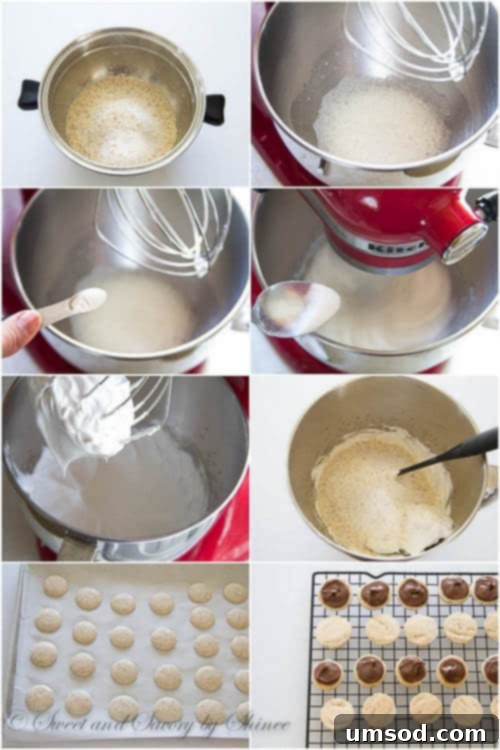
Troubleshooting Macaron Issues: Perfecting Your Bake
Did your chocolate hazelnut macarons turn out a little less than perfect? Don’t worry, macaron baking has a learning curve, and even experienced bakers encounter challenges. Whether your shells are cracked, hollow, or spreading too thin, a solution is often within reach. Check out my comprehensive macaron troubleshooting guide. It offers detailed visuals and expert suggested fixes for common macaron woes, helping you identify and correct issues with ease.

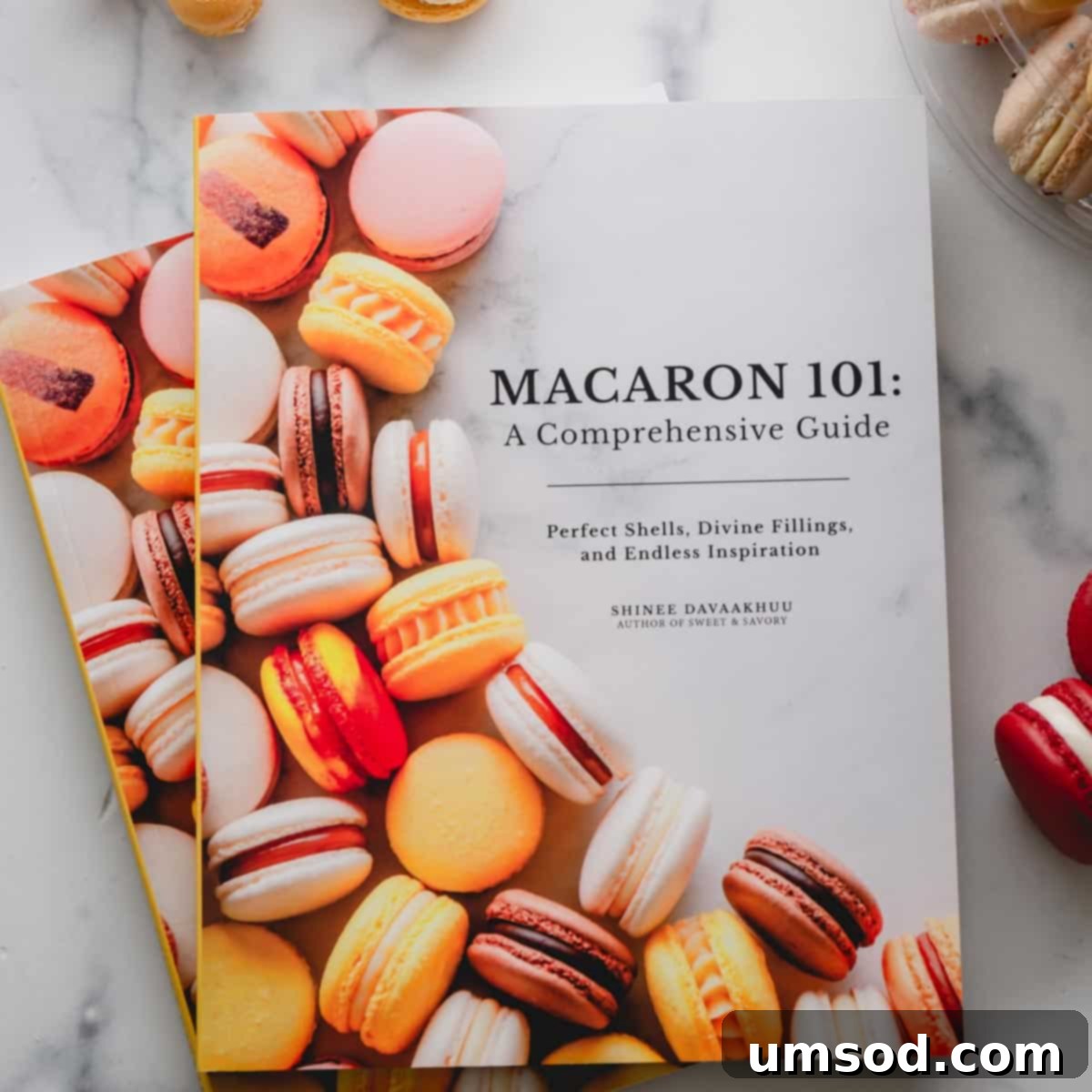
Macaron 101: A Comprehensive Guide
Ready to elevate your macaron skills? Master the art of French macarons and unlock the secrets to creating your own signature flavors!
Watch the Video Tutorial: Perfect Macarons Every Time!
We truly hope you’re inspired to try these incredible chocolate hazelnut macarons soon. They are a testament to how simple yet sophisticated homemade treats can be, especially with a little Nutella magic. Please let us know in the comments if you give them a try!
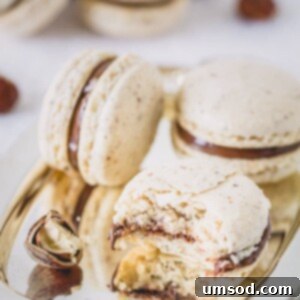
Chocolate Hazelnut Macarons
Shinee Davaakhuu
1 hr
20 mins
20 filled macarons
Comment
Print Recipe
Ingredients
For macaron shells:
-
60 g
finely ground hazelnut flour
Note 1 -
40 g
finely ground almond flour
-
65 g
powdered sugar
Note 2 -
70 g
egg whites
at room temperature -
¼ teaspoon
cream of tartar
Note 3 -
75 g
fine granulated sugar
Note 4
For filling:
-
½ -1 cup
Nutella
Instructions
- Preheat the oven to 300°F (150°C). Line 2 baking sheets with parchment paper, a Teflon sheet, or a silicone mat.
- To prepare dry ingredients, sift together hazelnut flour, almond flour, and powdered sugar twice. Note: If you have up to 2 tablespoons of chunky dry ingredients left in the sifter, you don’t have to replace it. Simply discard those chunky bits.
- To make meringue, in a clean mixing bowl with a whisk attachment, combine egg whites, granulated sugar, cream of tartar, and salt. Beat the mixture on medium speed until soft peaks form. (I set it to speed 4 on my KitchenAid stand mixer. It can take 30-40 minutes to whip the meringue, but it’s well worth it for nice and full shells.)
- Continue beating the egg whites on the same medium-low speed until hard peaks form. Visual cues: Meringue should ball up inside the whisk, and when you lift the whisk, the meringue should hold a pointy end and have sharp ribs.
- To make batter, sift dry ingredients into the meringue. Using a silicone spatula, fold the dry ingredients into the meringue until fully incorporated. Then continue to fold the batter until it’s runny enough to draw a figure eight. To test, take a small amount of batter and drop it into the bowl. If the small peaks dissolve into the batter on its own in about 10 seconds, the batter is ready. If not, fold a couple more times and test again. Be careful not to over-fold the batter. (TIP: Making French macarons is all about the technique. This is one of the most crucial steps. Let me try to describe the folding motion as best as I can: run the spatula clockwise from the bottom, up around the sides, and cut the batter in half. If you’re a beginner macaron-baker, I suggest counting every fold. It takes roughly about 50 folds to reach the proper consistency. After 50 folds, start testing the batter, and continue testing after every couple of folds.)
- To pipe macaron shells, transfer the batter into a pastry bag, fitted with a round tip. (I used this Wilton 2A tip.)
- Hold the pastry bag at a straight 90° angle and pipe about 1.5-inch rounds about an inch apart on prepared baking sheets. (TIP 2: I made a perfect macaron template for you. Simply pipe the batter to fill the inner circle.)
- Tap the baking sheets firmly on the counter (or using your hand) a few times to get rid of any air bubbles. You can also use a toothpick to burst some large air bubbles. This step ensures smooth tops.
- Let the macarons rest on the counter for 15 minutes before baking.
- Meanwhile, preheat the oven to 300°F (150°C). Note: I don’t use convection settings. I set my oven to heat from top and bottom.
- To bake, working one baking sheet at a time, place one tray with macarons on the middle rack. (TIP: To prevent browning, place an empty baking sheet on the top rack to shield the heat.) Bake for about 15-18 minutes. It’ll take longer for larger macarons. To test for doneness, touch a macaron lightly and try to move it. If it slides and wobbles, bake a minute or so longer. The cooked macarons should be firm to touch and the base shouldn’t move. (TIP: It’s always better to slightly over-bake macarons than under-bake them!)
- Cool the macarons on the sheet for 10-15 minutes, and then transfer onto a wire rack to cool completely.
- To assemble macarons, pair the macaron shells by size and arrange them on a wire rack. Line them up so that bottom shells are upside down.
- Pipe a thick layer of Nutella on bottom shells. Place the top shell over the filling and press lightly so the filling spreads till the edges.
- Store the filled macarons in an airtight container in the fridge for at least 8 hours, or preferably 24 hours to mature, which allows the filling to soften and flavor the shells.
- To serve, bring the macarons out about 30 minutes prior to serving.
⭐️ Did you make this recipe?
Please leave a review and let us know how you liked it!
Tips & Notes
Note 2: I don’t recommend making your own powdered sugar, because commercial powdered sugar has cornstarch in it, which helps with the texture of the cookies.
Note 3: Cream of tartar is optional and can be omitted. However, it helps to stabilize egg whites and create sturdier meringue. It’s an extra insurance for success!
Note 4: It’s important to use fine granulated sugar for meringue, as it dissolves quicker. You can also use caster sugar, aka baker’s sugar.
Note 5: Read this post for must-have macaron tools.
Got macaron trouble? Check out my visual troubleshooting guide.
Nutrition
1 macaron
27kcal
4g
1g
1g
4g
3mg
Dessert
French
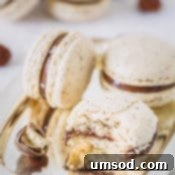
Did you make this?
Leave a rating and your feedback. Thank you!
This recipe was originally published on July 23rd, 2015, and was last updated with enhanced tips and instructions on March 9th, 2021, to ensure the most successful baking experience.
